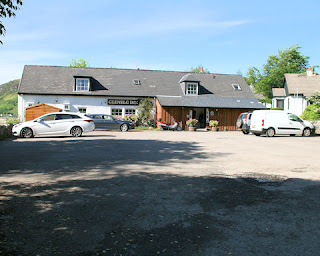We ended the
sightseeing portion of our vacation at the Culloden Battlefield near Inverness.
That’s where Bonnie Prince Charlie suffered his final defeat. Unfortunately, it
was raining, so we spent most of our time inside at the exhibit. I stepped
through the door long enough to take pictures of the battlefield but did not
walk around and read the markers.
Dr. Samuel Johnson
and James Boswell visited Inverness twenty-seven years after Bonnie Prince
Charlie’s defeat. The two men took in Inverness on their way to the islands,
but they didn’t say anything about visiting the battlefield, so they probably
didn’t. However, they met the heroine of the piece when they reached Skye. By
then, Flora MacDonald was married, but her last name was still MacDonald. (It
was a common name on Skye.) They found her to be a woman of middle stature,
gentle manners, and much courage.
Flora MacDonald
helped smuggle the fugitive Prince Charlie out of Scotland by dressing him as
her maid and taking him “over the sea to Skye.” He remained hidden—although not
in women’s clothing—until he caught a French boat and returned to exile in
France. These events have been imortalized in “The Skye Boat Song,” written by
Sir Harold Boulton in the late 19th century. It goes like this:
[Chorus:] Speed, bonnie boat, like a bird on the wing,
Onward! the sailors cry;
Carry the lad that's born to be King
Over the sea to Skye.
Onward! the sailors cry;
Carry the lad that's born to be King
Over the sea to Skye.
Loud the winds howl, loud the waves roar,
Thunderclaps rend the air;
Baffled, our foes stand by the shore,
Follow they will not dare.
Thunderclaps rend the air;
Baffled, our foes stand by the shore,
Follow they will not dare.
[Chorus]
Though the waves leap, soft shall ye sleep,
Ocean's a royal bed.
Rocked in the deep, Flora will keep
Watch by your weary head.
Ocean's a royal bed.
Rocked in the deep, Flora will keep
Watch by your weary head.
[Chorus]
Many's the lad fought on that day,
Well the claymore could wield,
When the night came, silently lay
Dead on Culloden’s field.
Well the claymore could wield,
When the night came, silently lay
Dead on Culloden’s field.
[Chorus]
Burned are their homes, exile and death
Scatter the loyal men;
Yet ere the sword cool in the sheath
Charlie will come again.
Scatter the loyal men;
Yet ere the sword cool in the sheath
Charlie will come again.
Charlie never did
come again as far as we know, at least not to lead another rebellion. There
were rumors that he secretly visited London years later, but nothing came of
his return if it did happen.
As far as I’m
concerned, our Scotland trip was a success.
And I even found some
literary connections.

















